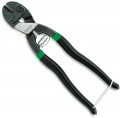Steel grade
The grade of steel from which the scissors are made — or at least their cutting part (in some models, the material of the handles may differ from the material of the knives).
This parameter is most often indicated by the type of steel or by the main alloying components included in its composition. For example, the designation CS stands for "carbon" and refers, usually, to traditional unalloyed tool steel. Such steel is prone to corrosion under the influence of moisture, including atmospheric, so it is advisable to periodically lubricate such a tool and keep it in a place with low air humidity. Markings Cr-V and Cr-Mo denote steel with chromium-vanadium and chromium-molybdenum alloying additives, respectively. Both of these varieties are highly resistant to corrosion, while the addition of molybdenum allows you to also reduce weight without sacrificing strength. There is also a tool made of stainless steel marked SS; such an alloy contains only chromium as an alloying additive. Other types of steels are rarely used in metal shears; a description of such materials, if necessary, can be found in special sources.
Steel hardness (HRC)
The hardness of the steel from which the scissors are made — or at least the cutting part of the scissors (handles and other elements can be made of other types of metal, softer). Indicated on the Rockwell scale in points; the higher the score, the harder the steel.
The general rule is that the hardness of the cutting edges should not be lower than the hardness of the material being cut — otherwise the quality of the work will noticeably deteriorate, up to the complete impossibility of making a cut. The minimum hardness found among metal shears is 40 HRC, and the highest is about 65 HRC. Most often, this is quite enough: most of the metals that you have to work with with scissors, without special hardening, have a hardness of up to 25 – 30 HRC. But if the tool is planned to be used for high-strength alloys, it is worth clarifying whether its hardness will be enough for this.
Also note that higher hardness increases the overall efficiency of the tool and allows it to retain sharpness for a long time; on the other hand, as hardness increases, the metal becomes more brittle and harder to sharpen. Conversely, softer steel is relatively quickly wrinkled and blunted, but it is also restored without much difficulty.
Spring-loaded
The presence in the scissors (usually manual for sheet metal, see "Type") of a special spring that works to open the jaws. In other words, the working stroke of the handles (for cutting) in such a tool occurs due to the effort of the user, and they are pushed back (to open) by a
return spring. This feature provides additional comfort when working, in fact, relieving the user of the need to make efforts to open the jaws.
Blade lock
The ability to lock the scissor blades in the closed position — it is in this position that the tool is most secure, it is also prescribed for storage and transportation (to avoid contact of the blades with foreign objects). Locking is usually done by means of a device that holds the handles of the scissors together — for example, a loop that connects the ends of the handles and is removed for the duration of work.
Length
The total length of the tool.
This parameter is specified for manual sheet metal shears (see "Type") and tools of a similar design. In addition to dimensions, it determines another important point — the working force. The greater the length of the scissors, other things being equal, the greater the length of the lever that the user acts on, and the greater the force transmitted to the jaws with the same pressing force. Accordingly, tools for working with thick and hard materials inevitably turn out to be long (for example, the length of a bolt cutter can exceed 1 m). And short handles make the scissors easy to store and transport, but require more effort when working.

